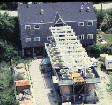

 | |||||||||||||||
|
|
Journals 2007/2008Janet Miele
July 16, 2007 Today I drove to the University Of Rhode Island Graduate School Of Oceanography and the MERL labs (Marine Ecosystem Research Laboratory) where I met Leslie Smith, the graduate fellow I would be working with for my ARMADA research experience. The MERL lab is situated on a hill just above Narragansett Bay.
Leslie met me at the front door of MERL and gave me a quick tour of the lab. Leslie explained that she was just completing the first year of her fellowship under the direction of Dr. Candace Oviatt. She was working on a project to track the primary productivity and respiration in different areas of Narragansett Bay by testing the effects of water column metabolism on hypoxic events. This project had arisen in response to the August 2003 fish kill in Greenwich Bay. Leslie's project was a NOAA funded project with the goal of creating a hybrid biological and physical simulation model of the Narragansett Bay. Her part in this project is to collect raw metabolism data. She has set up six stations that transect down the West Passage of Narragansett Bay. At each of these stations, a small boat crew collects water samples for testing in the lab and real time physical data for each station (temperature, salinity, fluorescence, pH and chlorophyll). Ideally, the MERL boat goes out twice a week in the summer sampling three stations each cruise. As you can imagine, these small boat cruises are weather dependant. Additional data is gathered once a month during the NuShuttle Cruises conducted by NOAA crew.
Today, Leslie was waiting for her water samples from South Ferry, North Prudence Island, and Mount View. These sampling sites also coincide with the remote sensing buoys maintained by a coalition of organizations such as the Department of Environmental Management, the Narragansett Bay Commission, and Save the Bay. Leslie explained by choosing six of the 18 buoy cites, she would be able to "double check" her study results with their data. Leslie has three other students working with her. Katie is a recent graduate of South Kingstown High School who will be attending the University of New Hampshire in the fall. Hannah is an undergraduate at the University of Rhode Island who works in the lab as her "part time" job. Matt is a second year Masters Degree candidate who is working in the lab in order to complete his thesis work. All three of these "helpers" are highly skilled and motivated students. Leslie sets out the day's activities and this very capable crew follows through. The water samples arrived at about 12:30. The team quickly sprung into action. Each carboy was held in a cooler so that the samples would not degrade. The coolers were slid into the chlorophyll room where yellow light bulbs are used to minimize the red/blue wavelengths necessary for chlorophyll to continue to photosynthesize thus degrading the samples and data. Each large carboy had to be poured off into many small and large dissolved oxygen bottles for testing. A system of tubes was used to set up a siphon that would not introduce extra oxygen into the samples. Two people filled the sample bottles while another added the chemicals to "fix" the oxygen in the sample. A set of large bottles was then covered with black cloth so that no additional light would get in so that respiration could be measured. These bottles were then transported to the incubator where they were incubated overnight. The smaller bottles were put into an incubator with a light box underneath that allowed varying amounts of light into the sample bottles in order to test photosynthesis. These too were incubated overnight before being tested. Their ability to quickly handle and fix the many dissolved oxygen samples while following protocols that Leslie and Dr. Oviatt have put together was amazing to watch. They have a rhythm and cadence I would not have expected from such a young work force. Equally as amazing was the fact that much of the sampling and incubating equipment had to be made by hand in order to standardize their testing protocols. For example, the water incubators that were testing the effects of differing amounts of light were named for the people who had fabricated them, Edwin and Jamie. Move over MacGyver! This energetic bunch wasted no time getting me into the fray. Matt showed me how to filter each sample with a siphon filter in order to do a chlorophyll study. An aliquot of 10 mL per filter with four filtrations per sample had to be run. The filter papers were folded in half and two filters were wrapped in aluminum foil and stored in the freezer for later testing. Here they were also running duplicate tests, one at -80°C and one at -4°C to check the efficacy of the standard method. I got my 12 little filters done in the same amount of time that it took this crew to fill, fix and incubate 100 plus sample bottles. Hmm... food for thought. |
||||||||||||||


